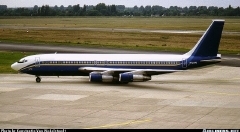NOTE: THIS PAGE HAS A LOT OF GRAPHICS.
PLEASE BE PATIENT AS THE PAGE LOADS.
updated 2/20/2000
THE BOEING 707 PAGE
(...continued...)
...America's first. And finest.

Pictured at left is a 707 model -100 originally
delivered to American Airlines. It has a smaller
fuselage and a shorter tail than the -300 Inter-
continental version. Compare this airplane to
the 707-300 Intercontinental pictured below, left.
The difference in appearance is striking, when
both aircraft are near each other.
NOTE: IF YOU CHOOSE THE "FULL SCREEN"
OPTION FOR YOUR BROWSER WINDOW, ALL
THREE PICTURES WILL BE ABLE TO BE VIEWED
AT ONCE FOR COMPARISON.

Although these two 707s appear identical when viewed
separately, the differences between the two are very
noticeable when viewed together. Compare the fuselage
length, and the tail height between the two. This is a
long-range 707-300 Intercontinental model, larger than
the -100 pictured at left.
NOW, THEN: compare the 707's smaller
brother, the 720, pictured at left, to the two
model 707s, above. The size difference is very
noticeable, even to the untrained eye. The
Boeing 720 was an airplane developed prior
to the 727 aimed at medium capacity, medium
range markets in North America and Europe.
One sure way of telling the difference be-
tween a 720 and and 707 is the overwing
exits: the 720 will have one (due to reduced
passenger capacity), and the 707 will
have two.
And, the 707 series 400, the final version of this jetliner, was the "grand-daddy" of all 707s: it was the
largest, longest raged, most powerful 707 to come from Boeing. (pictured below):

The Boeing Company has a major reputation for designing and building a strong and durable airplane.
This was particularly true of the 707 as it was America's first commercial jetliner and some technologies
were either new or still being researched. So the 707, and its counterpart, the 720, were actually over-
designed and overbuilt, which resulted in an airplane, as the mechanic Joe Patroni (George Kennedy),
in the movie "Airport", observed, "Take the wings of this and you can use it for a tank. This airplane can
withstand anything!" No other commercial jetliner, before or since, in fiction or non-fiction, has
been referred to that way.
And "Joe Patroni", fictional though he was, was not far from the actual truth. Two particular events in
which the 707 was involved stand out; in both cases, the mighty 707 brought all passengers and crew
home safely. In one event, a Pan American 707 Intercontinental had just departed San Francisco for a
routine hop across the Pacific Ocean. Shortly after takeoff, the passengers onboard watched in horror
as the right wing exploded as a result of the disintegration of the number four engine. The wing burned
terribly as the now ruptured fuel tanks spewed out fuel; twenty five feet of the right wing, along with
the exploded engine, was gone. The flight crew, now really earning that paycheck, conducted an emergency
landing at Travis Air Force Base without further incident. No one onboard was injured.
Another event of note involved a 707 which collided in mid-air with a Lockheed Constellation over
New York City. This time, 30 feet (almost half) of the left wing and the outbourd engine
were gone. The 707 continued to fly, and an emergency landing was made. Again, no one onboard was
injured.


Above, a 707-300C (C stands for Cargo version), of
Ecuatoriana Jet Cargo landing at Miami. At right, a
707 jet tanker prototype at the Farnborough Air Show.
Go back
one page
Go to
Site Map
Send me an
E-mail!
Go to
next page
Boeing and all associated aircraft designs and designations are trademarks of The Boeing Company,
Seattle, WA, USA.
All airline paint schemes and logos pictured here are trademarks of the individual air carriers, if applicable.